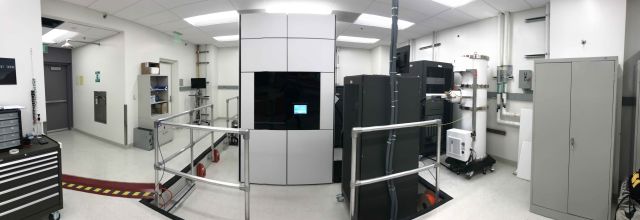BioPACIFIC MIP has signed off on the state of the art microED
MicroED at BioPACIFIC MIP now online!

There’s a new shared-use electron microscope at UCLA for investigators seeking to elucidate the atomic structures of bio-sourced monomers and small molecules. The NSF’s BioPACIFIC MIP now offers access to its ThermoFisher Scientific Spectra 300C transmission electron microscope (TEM) housed at the California NanoSystems Institute at UCLA.
The recent acquisition is a cornerstone technology of the BioPACIFIC Materials Innovation Platform (BioPACIFIC MIP), a collaboration between UCLA and UCSB funded by the National Science Foundation. The program is dedicated to designing sustainable bio-based alternatives to polymers derived from petroleum. In support of that vision, the new state-of-the-art and first-of-its-kind TEM is optimized for high throughput determination of atomic structure using micro-electron diffraction (microED). By acquiring diffraction patterns at different angles through a continuous rotation and then processing the acquire tilt-series through a series software analysis tools, the 3D atomic structure of a bio-sourced monomer can be determined.
“This tool can acquire the data to determine a structure within minutes, as compared to days in the case of direct imaging structural determination, and longer time periods when using x-ray synchrotrons. The time to determine a structure is therefore shortened, closing the feedback loop of informed discovery of new materials, which is an excellent example of how the Materials Genome Initial can be applied here”, said Dr. Matthew Mecklenburg, project scientist at BioPACIFIC MIP and Managing Director of Electron Imaging Center for Nanomachines at UCLA. “Such capabilities can fill an important role by giving more people than ever before access to fast, easy, and reliable structure determination.”
The state-of-the-art microED is the first 3rd generation Spectra-class microscope, to have a large gap electromagnetic pole piece, an anti-ice contamination mechanism, high speed high tension switching capability, and a next generation high brightness field emission electron source. The samples are often interrogated by the incident electrons while under cryogenic conditions. The wide gap pole piece gives room to maneuver when performing electron diffraction tomography, while the anti-ice device prevents any significant ice building up from the water vapor in the vacuum from freezing onto the sample. The fast switching between different accelerating voltages allows for interrogation of a wide variety of sample thicknesses. The high brightness field emission electron source, also called an X-CFEG or cold FEG, can produce a beam of electrons with more that are more wave like than before.
Users of the microED can also utilize other high-throughput facilities of BioPACIFIC MIP to accelerate small molecules and materials discovery. The Living Biofoundry, also housed at UCLA, is specially designed for automated synthetic biology and microbial engineering, and scientists can mine a data library of biosynthetic pathways to accelerate the discovery and scaled-up production of bioderived building blocks and biopolymers. The Automated Synthesis Platform and Solid-State Synthesizer, housed at UCSB, are designed for high-throughput synthesis of polymers and peptides/peptoids respectively. The novel approaches pioneered at BioPACIFIC MIP will benefit both UCLA and UCSB users as well as the broader research community.
Inquiries about the microED, including requests for access or project consultation, can be directed to biopacificmip@cnsi.ucla.edu.